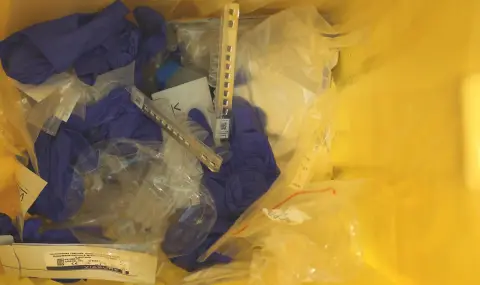Soon, a scandal broke out once again with the garbage of the capital's hospitals, and the municipality announced that they would stop accepting it. This happened after the garbage processing plant once again found that household waste was mixed with hazardous medical waste. The municipality announced that the measures were preventive, expecting action and legislative changes. The reaction of the Minister of Health Silvi Kirilov was to announce that everything was fine in the hospitals, the responsibility lies with the companies transporting the waste, and to say that this could cause an epidemic. He stated that an interdepartmental working group would be formed to propose regulatory changes. Then the companies that transport household waste announced that it was not their fault, because they only transport the waste to the landfill. The reality - hospital waste enters the Sofia garbage plant, and everyone says,
that he is not guilty.
The question also arises, what is happening in the country? The practice is hardly any different. Yes, the garbage has carried itself to the bin. It has grown a step and went to throw itself out!? Naturally, the Regional Inspectorate for Environmental Protection and the Regional Institute of Health and Health found no violations, but everyone is unhappy that hospital waste has reached the garbage plant in the capital. There are 15-16 companies in the country that have been issued a permit for the preliminary treatment of hazardous hospital waste.
What is the path of the garbage
Body parts, expired medicines, cytostatics, etc. are burned in incinerators, infectious waste can be autoclaved, and landfilling is permitted for household waste from hospitals. In autoclaves, waste is sterilized at a lower temperature, after which the waste is considered to be decontaminated to the point of being taken to a landfill. When the waste transport company picks up the containers from the hospital, it has no way of knowing what they contain. If hazardous waste is being transported, the truck driver receives an identification card from the hospital, which contains the name of the hospital, the name of the waste transport company, the weight of the waste, the date and time, as well as codes that indicate the contents of the waste containers.
Where to transport
Depending on these codes, the company transports the waste to the appropriate location - a plant, an autoclave, an incinerator. The truck driver has no way of really knowing what the containers contain; he is guided by the codes indicated on the identification card. This card is issued in several copies, one each being received at the hospital, the transport company, the autoclave or the incinerator, depending on where the waste is processed, as well as at the Regional Inspectorate for the Environment and Water. The identification card is filled in by the person responsible at the hospital, who should know which waste is being transferred with which code and where it is being directed.
Some hospitals dispose of masks, aprons, etc. together with household waste. According to the waste classification regulation, these, including disposable diapers and plaster casts, are not hazardous waste, but they are not household waste either. Non-hazardous medical waste can be disposed of through the waste disposal system if it has been used, but has been decontaminated by sterilization in the hospital itself and does not contain blood, secretions, or sharp objects.
And here comes the contradiction, because the plant in Sofia has the right to accept waste with code 180104 - socks, masks, aprons, plaster casts, disposable diapers, if they have been decontaminated, but this waste is not allowed to go to the separation plant, where people manually separate it. This type of waste must be landfilled and composted. However, the staff of some hospitals does not separate household waste from non-hazardous medical waste.
Needles, for example, are not autoclaved; they must be burned in an incinerator. Body parts also cannot be autoclaved; they must be burned directly. Cytostatics used in oncology departments, as well as expired drugs, must be burned. If waste containing body parts is thrown away in the household waste while still in the hospital, all this general waste will be transported to the plant.
There are two more serious problems - unscrupulous companies that do not treat the waste, but directly dispose of it, and the inefficient waste reporting system that no one controls.
A big problem is the waste reporting system. It does not work well because it is based on the principle of “what I declare“. Or nothing may be declared. Simply, no one checks and compares the data and whether the declared in the documents correspond to the waste actually transported.
Unscrupulous companies
Of course, there are various companies transporting hazardous waste, and those operating autoclaves that do not treat the waste – do not sterilize it. Thus, the waste continues to be infectious in nature, and is dumped in a landfill. Control is divided between regional health inspectorates, which can only inspect the territory of hospitals, and regional environmental inspectorates, which inspect the final reception facilities. Somewhere along the way, however, things get confused. There is no control body to check whether the autoclave has worked as long as it declared, in order to take samples after sterilization to see if the infectious waste is disinfected.
There are also violations in the issuance of permits for autoclaving hospital waste. A mandatory element in these documents is the indication of the capacity of the installation. The documents of some sterilization companies state that their capacity is 1,000 tons per year, while the company has concluded contracts for 2,000 tons per year. It is obvious that 1000 tons go somewhere untreated.
Next…
How do they deal with this waste in Europe...
Expired medicines – responsibility or just business?
The waste reporting system is a big problem, because it is based on the principle of "what I declare
Apr 28, 2025 13:02 32
